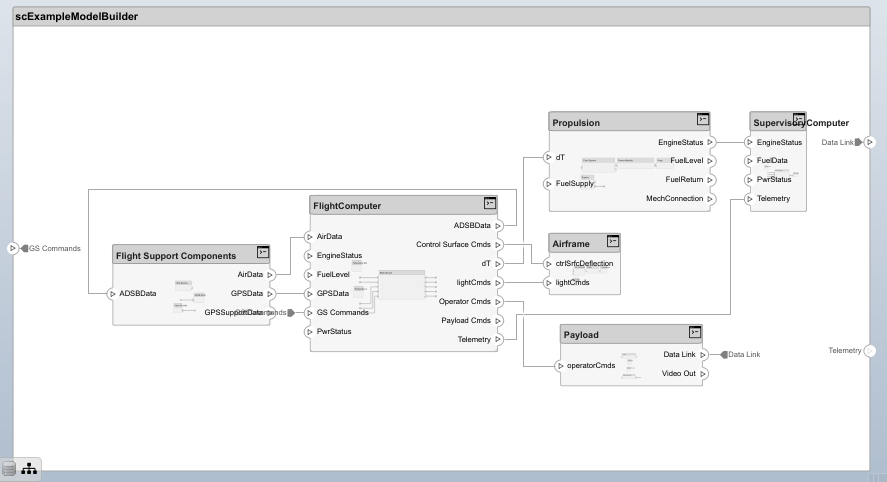使用 systemcomposer.io.ModelBuilder 实用工具类将架构规范导入 System Composer™。这些架构规范可以在外部源(例如 Excel® 文件)中定义。
在 System Composer 中,架构由以下四组信息完整定义:
组件及其在架构层次结构中的位置
端口以及端口与组件的映射关系
组件之间通过端口的连接关系
架构模型中的接口以及接口与端口的映射关系
此示例使用 systemcomposer.io.ModelBuilder 类传递上述所有架构信息,包括来自外部源的接口数据定义,并导入一个 System Composer 模型。
在此示例中,我们在一个 Excel 电子表格中定义了一个小型无人机系统的架构信息,用它来创建 System Composer 架构模型。
外部源文件
# Element : Name of the element. Either can be component or port name.
# Parent : Name of the parent element.
# Class : Can be either component or port(Input/Output direction of the port).
# Domain : Mapped as component property. Property "Manufacturer" defined in the
profile UAVComponent under Stereotype PartDescriptor maps to Domain values
in excel source file.
# Kind : Mapped as component property. Property "ModelName" defined in the
profile UAVComponent under Stereotype PartDescriptor maps to Kind values
in excel source file.
# InterfaceName : If class is of port type. InterfaceName maps to name of the interface
linked to port.
# ConnectedTo : In case of port type, it specifies the connection to
other port defined in format "ComponentName::PortName".
# Name : Name of the interface or element.
# Parent : Name of the parent interface Name(Applicable only for elements) .
# Datatype : Datatype of element. Can be another interface in format
Bus: InterfaceName
# Dimensions : Dimensions of the element.
# Units : Unit property of the element.
# Minimum : Minimum value of the element.
# Maximum : Maximum value of the element.
步骤 1:实例化 ModelBuilder 类
您可以使用配置文件名称来实例化 ModelBuilder 类。
指定要构建的模型的名称。
指定配置文件的名称。
指定要读取架构信息的源文件的名称。
实例化 ModelBuilder。
步骤 2:构建接口数据定义
读取外部源文件 DataDefinitions.xlsx 中的信息,以构建接口数据模型。
从 Excel 源文件创建 MATLAB® 表。
强制 readtable 从第二行开始读取信息。
systemcomposer.io.IdService 类为给定键生成唯一的 ID。
对于接口,将接口名称添加到模型构建器中。
获取唯一接口 ID。
getID(container,key) 会为指定容器内的输入键生成或返回(如果键已存在)相同的值。
使用 builder.addInterface 将接口添加到数据字典中。
对于元素,读取元素属性,并将元素添加到父接口中。
ElementID 在同一接口内是唯一的。为统一格式,在 ID 前加上 E。为输入元素生成的 ID 在以父接口名称作为容器的范围内是唯一的。
设置元素的数据类型、维度、单位、最小值和最大值属性。
确保构建器实用工具函数的输入始终为字符串。
使用 builder.addElementInInterface 在接口中添加一个带有属性的元素。
步骤 3:构建架构规范
架构规范由 Excel 源文件中的 MATLAB 表创建。
遍历表中的每一行。
读取 Excel 文件中的每一行和每一列。
填充表内容。
Root ID 默认设置为零。
使用 builder.addComponent 添加组件。
读取属性值。
使用 builder.setComponentProperty 设置构造型和属性值。
在此示例中,通过串联端口名称和父组件名称作为键,生成端口的唯一 ID。
对于根架构上的端口,假定 compID 为 0。
使用 builder.addPort 添加端口。
InterfaceName 指定与端口关联的接口的名称。
获取接口 ID。
getID 将返回在步骤 2 中添加接口时已生成的相同 ID。
使用 builder.addInterfaceToPort 将接口映射到端口。
读取 ConnectedTo 信息,建立组件之间的连接。
ConnectedTo 的格式为:
(DestinationComponentName::DestinationPortName)
在此示例中,将当前端口视为连接的源端口。
获取连接端口的端口 ID。
在此示例中,端口 ID 由端口名称和父组件名称串联生成。如果端口 ID 已生成,则 getID 函数会为输入键返回相同的 ID。
填充连接表。
使用 builder.addConnection 添加连接。
步骤 3:使用 builder.build 函数从填充好的表导入模型
注意:接口兼容性检查会将不匹配接口的连接器突出显示为黄色。
清理生成的临时文件。
Copyright 2020 The MathWorks, Inc.
